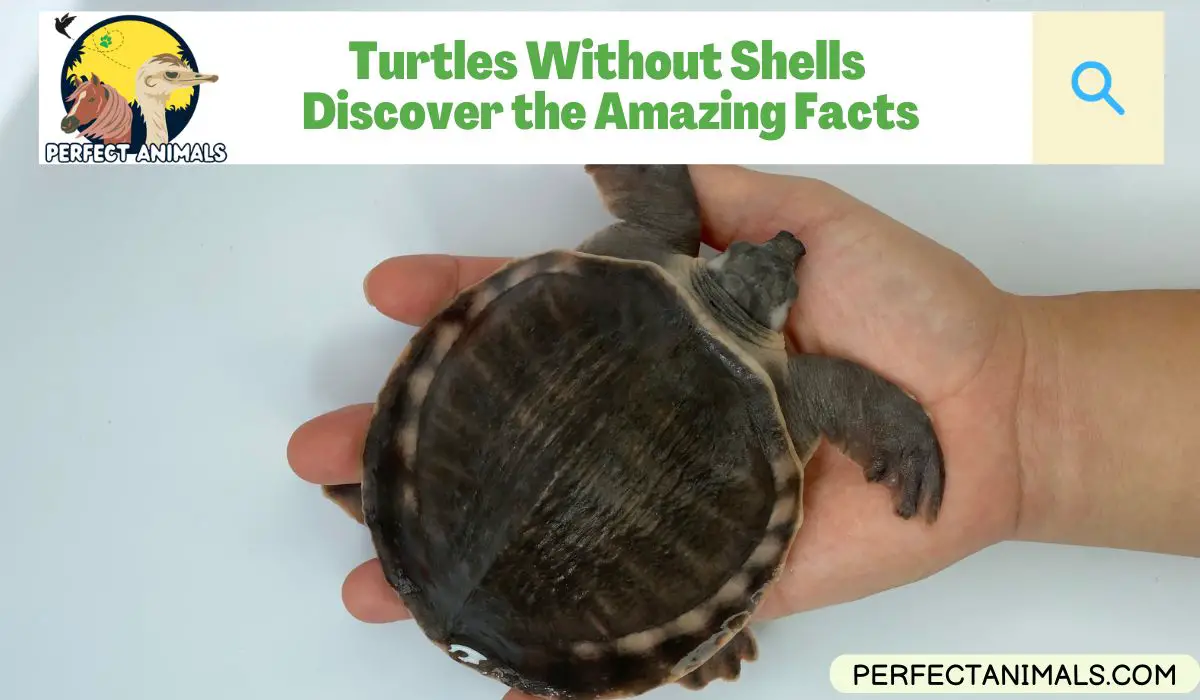Turtles are known for their protective shells, but some turtles actually don’t have shells.
Turtles without shells, often called shell-less turtles, go against what we typically think of when we imagine these reptiles.
In this article, we’ll explore the topic of “turtles without shells” and discuss whether turtles are born with shells, if any turtles actually don’t have shells, how they survive without this protection, and more.
While a shell is vitally important for most turtles, there are some unique species that go shell-less.
Keep reading to learn all about these fascinating animals and why some turtles don’t need shells to survive.
Are Turtles Born With A Shell?
When turtle eggs hatch, the baby turtles that emerge do have shells.
However, their shells are soft and leathery at first. The shells have not yet fully formed and hardened.
A turtle’s shell develops as the turtle grows, with the ribs expanding and the vertebrae broadening.
This forms the basic structure of the shell.
The bony external plates that create the hard outer surface don’t begin mineralizing and hardening until later on.
So while newborn turtles have the early beginnings of a shell, their shells are still soft and pliable.
It takes time for the shell to fully form and harden into the protective armor shell we associate with adult turtles.
But they are born with an early, underdeveloped shell rather than no shell at all.
Related Article – Do Sea Turtles Drink Water?
Are There Any Turtles Without Shells?
Yes, there are actually a few species of turtles that lack a shell entirely.
These shell-less turtles are uncommon, but they demonstrate that shells are not a requirement for all turtles.

One example is the pig-nosed turtle which is found in New Guinea and Australia. True to its name, it has a distinctive pig-like nose and feet shaped like flippers. It lacks the bony plates and shells that typify most turtles.
Another shell-less turtle is the softshell turtle. There are many different softshell turtle species located in North America, Asia, and Africa.
As their name suggests, they have a leathery, flexible shell that feels soft when touched. The shell does not contain the hardened bony plates.
While very rare, some individuals of shell-bearing turtle species are born with physical deformations that prevent their shells from properly forming. This leaves them shell-less and vulnerable.
They typically do not survive long in the wild.
So while the vast majority of turtles need shells to protect themselves, there are a handful of unique species that demonstrate living shell-free is possible.
These shell-less turtles have adapted in other ways to survive without the protection of a full shell.
Related Article – Do Turtles Have Teeth?
Can a Turtle Survive Without Its Shell?
For most turtles, surviving without their shell would be extremely difficult.
The shell provides vital protections that are hard to replicate. Turtles’ shells shield them from predators, environmental dangers like harsh sun, and physical impact.
Without this protection, turtles would become very vulnerable.
However, the few shell-less turtle species that exist prove it is possible to survive and thrive without a complete shell.
Species like the pig-nosed turtle and softshell turtle have adapted to life without full-shell protection.
Pig-nosed turtles have thick, leathery skin and can retract their head for safety. Softshell turtles bury themselves in mud and sand, using their flat shape and flexibility to take cover.
Their soft shells and ability to hide help compensate for the lack of a hardened shell.
Additionally, some individual turtles in captivity have survived shell-less due to very careful human care.
But in the wild, survival rates for shell-less turtles are extremely low. They become easy targets for predators without shell protection.
Why Can’t You Take a Turtle Out of Its Shell?
While a turtle’s shell may seem like it’s detachable or removable, the shell is actually fused to the turtle’s skeleton and spine.
The shell is an integrated part of the turtle’s body, not just an external accessory.
Attempting to forcibly remove a turtle from its shell would cause severe damage to the turtle.
The shell has nerve endings wired into the turtle’s nervous system. Turtles can feel sensations and pain in their shells.
Removing the shell would mean ripping bones, tissue, muscles, and nerves still connected to the turtle’s body. This would badly injure and likely kill the turtle.
Additionally, a turtle’s body shape and organs conform to the shell’s shape.
Without the shell containing them, the turtle’s organs would be impacted. The turtle would be unable to move properly or perform basic functions once removed.
In the very rare case that a turtle’s shell is damaged and a piece needs surgical removal by a veterinarian, the turtle must be given special aftercare to survive without that shell section.
Even partial removal is extremely risky.
For these reasons, turtles remain inside their shells permanently.
Their shells are an inseparable part of their anatomy that cannot be detached without gravely harming or killing the turtle.
Related Article – Pink Belly Sideneck Turtles
Can Turtles Feel Pain On Their Shell?
Yes, turtles can feel sensations and pain on their shells. This is because the shell contains nerve endings that are wired into the turtle’s nervous system.
The top and bottom shells are fused to the turtle’s ribcage and spine. The shell is an external extension of the turtle’s skeletal system.
Where bone meets the shell, sensory nerves extend into the bony parts of the shell.
This allows turtles to feel pressure, touch, and pain on their shells. They can sense if something brushes against, taps on, or damages parts of the shell.
The presence of nerves means impacts like cracking or breaking the shell will hurt the turtle.
Research has shown that turtles definitively react to painful touch on their shells, withdrawing their limbs and head. They exhibit avoidance behaviors to protect the shell from further pain.
On the other hand, the scutes that form the outer keratin layer on top of the bony shell plates do not contain nerves.
The scutes themselves cannot sense pain, though the bony shell underneath can.
So while turtle shells may appear hard and armor-like, the living animal inside absolutely can feel what happens to the shell.
Turtles should be handled gently to avoid causing shell pain.
Their shells are a sensitive sensory part of their anatomy.
Final Thoughts
Turtles without shells may seem contradictory to everything we know about these reptiles.
When we picture a turtle, their signature shells are a key part of that image.
However, exceptions do exist where turtles are born without full shells or have adapted to life shell-free.
While shells provide vital protections for most turtles, they are not absolutely required for survival.
As we’ve explored, a handful of turtle species have found clever ways to endure without the typical hardy shell.
And even in the absence of a full shell, all turtle hatchlings emerge with a partial shell to start.
Still, losing its shell would prove extremely dangerous for the majority of turtles. Their anatomy and physiology is designed around the shell’s presence.
Even though shells can limit speed and agility on land, the benefits far outweigh any tradeoffs for most turtle species.
One thing is certain – the shell plays a central role in the turtle’s identity.
Whether present from birth or adapted without, it fundamentally shapes the turtle’s form and lifestyle.
The diversity of shelled and shell-less turtles demonstrates nature’s creativity in protection and survival.
FAQs
Can a turtle leave its shell?
No, a turtle cannot leave its shell because the shell is fused to the turtle’s skeleton and contains nerves wired into its nervous system.
Removing the shell would severely injure or kill the turtle.
Can a turtle live without a shell?
While very rare, some turtle species like pig-nosed turtles and softshell turtles can survive without a complete hard shell.
They have adapted with alternative protective traits. But most turtles require their shells to live.
Can a turtle’s damaged shell heal?
Yes, a turtle’s shell can heal if damaged. As long as the injury does not penetrate deep into the bony layer, the scutes and shell can regenerate over time. However severe damage to the bone itself cannot be repaired.
Resources – (for further reading)
National Aquarium – Pig-Nosed Turtle
National Wildlife Federation – Spiny Softshell Turtle
Chattahoochee Nature Center – A turtle’s shell is more than its home

Jesse is a dedicated animal keeper at Lincoln Park Zoo, where he attends to the needs of various mammal species. His hands-on experience and knowledge about animal behaviors and conservation fuel his passion for writing about wildlife during his free time.

